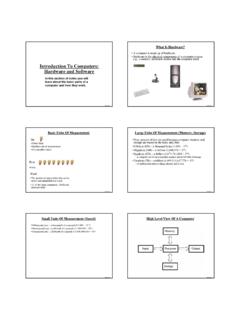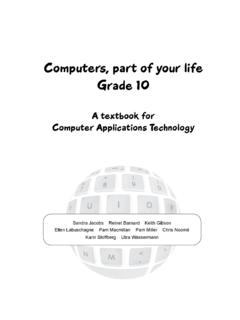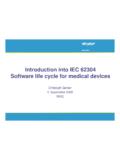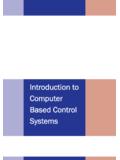Transcription of INTRODUCTION TO COMPUTER SYSTEM
1 INTRODUCTION to COMPUTER SYSTEM /1 Chapter 1 INTRODUCTION TO COMPUTER SYSTEM Objectives INTRODUCTION COMPUTER ? Evolution of Computers Classification of Computers Applications of Computers Advantages and Disadvantages of Computers Similarities Difference between COMPUTER and Human A COMPUTER SYSTEM Components of a COMPUTER SYSTEM Summary
2 Check your Progress - Answers Questions for Self Study Suggested Readings OBJECTIVES After studying this chapter you will be able to: Learn the concept of a SYSTEM in general and the COMPUTER SYSTEM in specific. Learn and understand how the computers have evolved dramatically within a very short span, from very huge machines of the past, to very compact designs of the present with tremendous advances in technology. Understand the general classifications of computers. Study COMPUTER applications.
3 Understand the typical characteristics of computers which are speed, accuracy, efficiency, storage capacity, versatility. Understand limitations of the COMPUTER . Discuss the similarities and differences between the human and the COMPUTER . Understand the Component of the COMPUTER . INTRODUCTION - COMPUTER Today, almost all of us in the world make use of computers in one way or the other. It finds applications in various fields of engineering, medicine, commercial, research and others. Not only in these sophisticated areas, but also in our daily lives, computers have become indispensable.
4 They are present everywhere, in all the dev ices that we use daily like cars, games, washing machines, microwaves etc. and in day to day computations like banking, reservations, electronic mails, internet and many more. The word COMPUTER is derived from the word compute. Compute means to calculate. The COMPUTER was originally defined as a super fast calculator. It had the capacity to solve complex arithmetic and scientific problems at very high speed. But nowadays in addition to handling complex arithmetic computations, computers perform many other tasks like accepting, sorting, selecting, moving, comparing various types of information.
5 They also perform arithmetic and logical operations on alphabetic, numeric and other types of information. This information provided by the user to the COMPUTER is data. The information in one form which is presented to the COMPUTER is the input information or input data. COMPUTER Fundamentals/2 Information in another form is presented by the COMPUTER after performing a process on it. This information is the output information or output data. The set of instructions given to the COMPUTER to perform various operations is called as the COMPUTER program.
6 The process of converting the input data into the required output form with the help of the COMPUTER program is called as data processing. The computers are therefore also referred to as data processors Therefore a COMPUTER can now be defined as a fast and accurate data processing SYSTEM that accepts data, performs various operations on the data, has the capability to store the data and produce the results on the basis of detailed step by step instructions given to The terms hardware and software are almost always used in connection with the COMPUTER .
7 The Hardware: The hardware is the machinery itself. It is made up of the physical parts or devices of the COMPUTER SYSTEM like the electronic Integrated Circuits (ICs), magnetic storage media and other mechanical devices like input devices, output devices etc. All these various hardware are linked together to form an effective functional unit. The various types of hardware used in the computers, has evolved from vacuum tubes of the first generation to Ultra Large Scale Integrated Circuits of the present generation.
8 The Software: The COMPUTER hardware itself is not capable of doing anything on its own. It has to be given explicit instructions to perform the specific task. The COMPUTER program is the one which controls the processing activities of the COMPUTER . The COMPUTER thus functions according to the instructions written in the program. Software mainly consists of these COMPUTER programs, procedures and other documentation used in the operation of a COMPUTER SYSTEM . Software is a collection of programs which utilize and enhance the capability of the hardware.
9 Check your Progress - 1. Fill in the blanks. a. The set of instructions to perform various operations is called a .. b. Compute means to .. of the COMPUTER . c. Mechanical devices are a type 2. Answer in brief. a. Define a COMPUTER .. b. What is software? .. INTRODUCTION to COMPUTER SYSTEM /3 1. 2 EVOLUTION OF COMPUTERS The computers of today are vastly different in appearance and performance as compared to the computers of earlier days. But where did this technology come from and Where is it heading?
10 To fully understand the impact of computers on today s world and the promises they hold for the future, it is important to understand the evolution of computers. The First Generation: The first generation computers made use of: Vacuum tube technology, Punched cards for data input, Punched cards and paper tape for output, Machine Language for writing programs, Magnetic tapes and drums for external storage. The computers of the first generation were very bulky and emitted large amount of heat which required air conditioning.
















